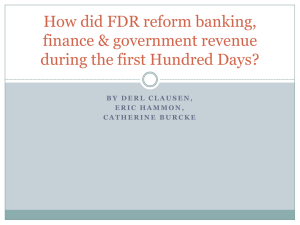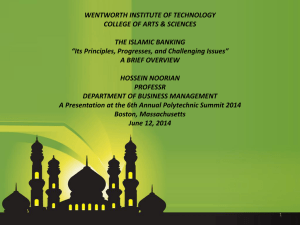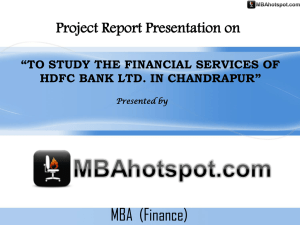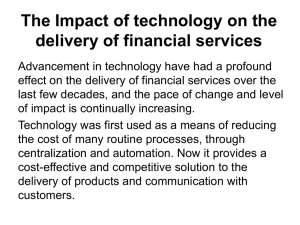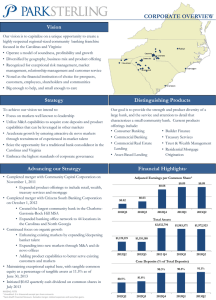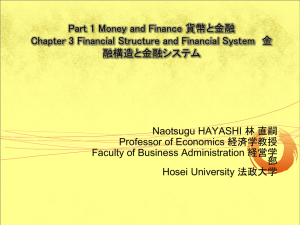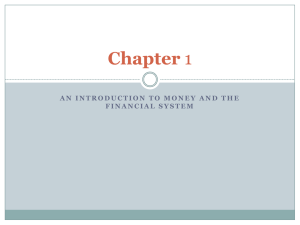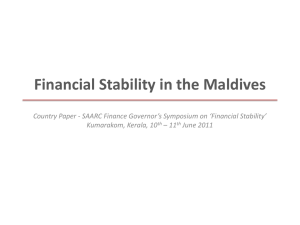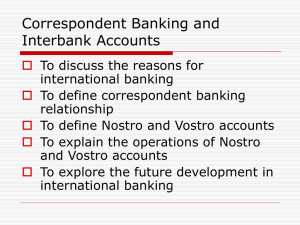Islamic Banks
advertisement
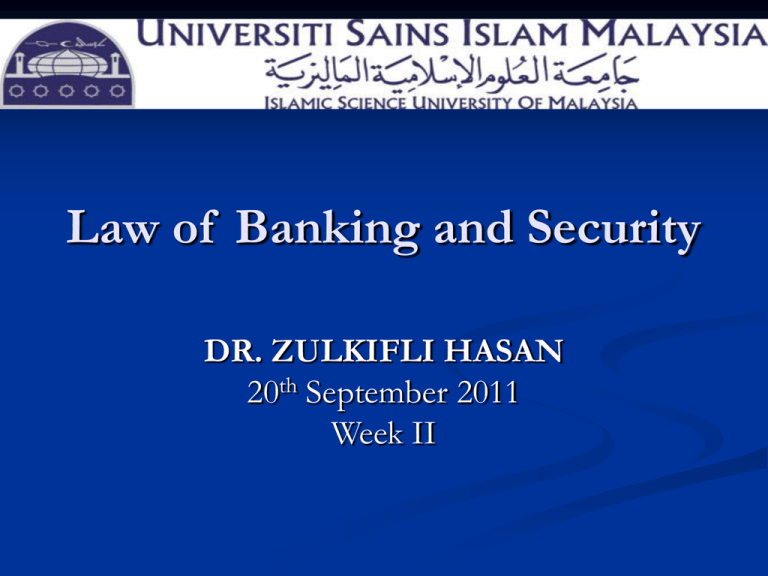
Law of Banking and Security DR. ZULKIFLI HASAN 20th September 2011 Week II Content An overview of modern financial management of banking, non-bank financial intermediaries and financial markets. The development of banking and financial institutions in Malaysia. Introduction Malaysia has a unique legislative framework consisting of mixed jurisdictions and mixed legal systems namely the common law and shariah. The growth and development of banking industry are supported through goods governance and its comprehensive legal frameworks. Financial System Banking System Non-Bank Financial Intermediaries Financial Markets Financial System Banking Capital Market Insurance Conventional Private/Public Debt Securities Money Market Conventionatial Islamic Stock Exchange Derivative Islamic Banking System Monetary Institutions- Central Bank, Monetary authority, Commercial Banks. Non-monetary Institutions- Finance Co, Merchant Banks and Discount Houses. Non Bank Financial Intermediaries Development Financial Institutions- Bank Pembangunan, BKR Saving Institution- National Saving Banks and Credit Cooperative Provident and Pension Fund-EPF, Pension Trust Funds, LTAT. Insurance Companies- Conventional and Islamic Other Financial Intermediaries- MBSB, Leasing Co. LTH. Financial Markets Money and Foreign Exchange- Market for securities less than 12 months to maturity. Eg- banker’s acceptance, negotiable instruments. Capital Market- Primary and secondary securities market. SC. Commodity Futures market and financial futures market and options marketCOMMEX, MDEX. BAFIA Deposit Taking Institutions Scheduled Institution Non-Scheduled Institution The Development of BFI Phase 1: 1840-1900: 7 Western banks were established. The Oriental Bank was set up in Singapore in 1846 The Mercantile Bank of India, London and China in 1855, The Chartered Bank of India,, Australia and China in 1859 The Asiatic Banking Corporation and the Commercial Bank of India both in the 1960's, Rhe Nederlandse Handel Matschappij (N. H. M. ) in 1883. The Hong Kong and Shanghai Banking Corporation in 1884. The Development of BFI Post 1900: Gradual emergence of local Chinese banks. The first local Chinese bank,, Kwong Yik Bank, was founded in Singapore in 1903. Kwong Yik (Selangor) Banking Corporation in 1913. The first bank incorporated in KL. Sze Hai Tong in 1906. Chinese Commercial Bank in 1912 Ho Hong Bank in 1917 Overseas-Chinese Bank in 1919. Lee Wah Bank, Bank of Malaya and Batu Pahat Bank in 1920 Ban Hin Lee Bank in 1935 United Overseas Bank in 1935. Malay bank was established in 1947 but it failed in 1952. Bank of Canton in 1953, Bank of America in 1955, Bank of Indonesia in 1955, Bank of Tokyo and Bangkok Bank in 1957 The Development of BFI Post 1957 Maybank Berhad and UMBC in 1960. BBMB in 1966. 1983 BIMB: Islamic Banking 1993: BBMB, UMBC and Maybank to open Islamic Banking window : SPTF 2004 - Foreign Islamic full-fledged banking license to Kuwait Finance House (KFH), AlRajhi Investment Bank, Saudi Arabia and Qatar Investment Group. 2011: 24 CB and 17 IB. BNM The idea had been first seriously mooted in the International Bank for Reconstruction Development Mission Report on the Economic Development of Malaya in 1955. The Central Bank of Malaya Ordinance 1958 (replaced by the CBA 2009) and the Banking Ordinance 1958 (replaced by the BAFIA 1989) BNM 2 Objectives: 1) To promote monetary stability and a sound financial structure 2) To influence the credit situation to the advantage of the federation The BNM is therefore charge with the task of implementing all the regulations concerned with these matters as laid by the law, as well as issuing policies and directives to further the implementation of these regulations. Where and when certain of the regulations have become inadequate or new or additional regulations become necessary, it is also the Central Bank's responsibility to initiate the formulation of such changes. BNM (a) to issue currency in the Federation and to keep reserves safeguarding the value of the currency (b) to act as banker and financial adviser to the government (c) to promote monetary stability and a sound financial structure SRR: S 36 BAFIA (d) to influence the credit situation to the advantage of the Federation Bank and bank “Bank” means the Central Bank of Malaysia established by the Central Bank of Malaysia Act 1958; “bank” means a person which carries on banking business; Sabah Development Bank Bhd v SKBS (Sabah) Sdn Bhd & Ors [1992] (1) MLJ 454: Development bank is not a bank and therefore banking license is not a requirement. Cooperative Central Bank v Belaka_Suria Sdn Bhd [1991] (3) MLJ 43.Cooperative Central Bank is not a bank. Restriction on the use of the term “bank” section 4 banking business “banking business” means—(a)the business of—(i)receiving deposits on current account, deposit account, savings account or other similar account;(ii)paying or collecting cheques drawn by or paid in by customers; and(iii)provision of finance; or(b)such other business as the Bank, with the approval of the Minister, may prescribe; Commercial Banks 24 Commercial Banks in Malaysia Largest and most important Provides current account facilities where payments can be effected readily through the issue of cheques. Islamic Banks 17 Islamic Banks: Islamic Banking Act 1983 banking business whose aims and operations do not involve any element which is not approved by the Religion of Islam; Development Finance Companies the business of providing capital or other credit facility on terms which would require the same to be utilised for industrial, agricultural, commercial or other economic development; and for the purposes of this definition, “development” includes the commencement of any new industrial, agricultural, commercial or other economic venture or the expansion or improvement of any such existing venture; or Discount House Receiving deposits on deposit account; the investment of such deposits and other funds of the institution in Malaysian Government securities, Treasury bills or such other investments as may be prescribed by the Bank; Finance Companies the business of receiving deposits on deposit account, savings account or other similar account; and giving of credit facilities, leasing business, business of hire-purchase, including that which is subject to the Hire-Purchase Act 1967 usiness of acquiring rights and interests in a hire-purchase, leasing or other similar transaction. Merchant Banks provision of finance (leasing business, lending, purchase of negotiable instruments, guarantee of any liability). providing consultancy and advisory services relating to corporate and investment matters making or managing investments on behalf of any person; merchant banks are basically specialised wholesale banking institutions looking after the affairs, in the majority of cases, of corporate clients rather than individuals. merchant banks cannot accept demand deposits or extend overdraft facilities. corporate finance and advisory services: services as underwriters for share issues and acting as share registrars ; providing advice on capital restructuring,, mergers and acquisitions ; promotion of new investment and joint ventures; and the undertaking of feasibility studies. Investment advice, which includes portfolio management and the establishment and management of investment and unit trusts. Banking intermediation services: the management of syndicated loans and the provision of acceptances and guarantees. Investment Bank 15 investment banks in Malaysia raise funds for businesses and some governments by registering and issuing debt or equity and selling it on a market. A financial intermediary that performs a variety of investment services, including underwriting, acting as an intermediary between an issuer of securities and the investing public, facilitating mergers and other corporate reorganizations and also acting as a broker for institutional clients. doesn't usually provide retail banking services investment bank's clients are institutional investors and high net-worth individuals Tutorial Presentation to brief banks’ profile. Name, Logo, Board of Directors, Capital, Products, Address and further particulars. Each group is allocated 15 minutes.

